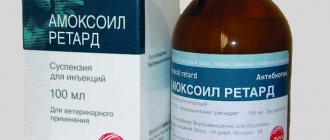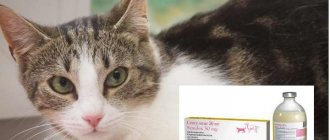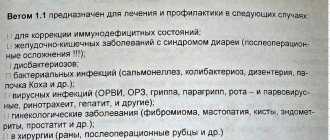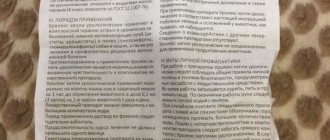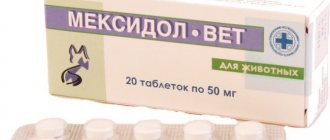When and why is rinsing necessary?
Animals are not always able to remove accumulated discharge from the outer and inner corners of the eyes. Therefore, the owner needs to periodically help the pet with hygiene. In other cases, rinsing becomes one of the methods of therapy when it is necessary to cure an eye disease.
Causes and symptoms of eye diseases
There is no need to panic if your pet’s eyes begin to water - perhaps a speck of dust has landed on the cornea, and the body has activated a protective reaction in the form of profuse lacrimation. Such conditions quickly, within one day, cease without human help. But there are also more serious cases - eye damage or diseases:
- Scratches and wounds
. A pet can get eye injuries during a fight, play, or fall. Symptoms include redness, swelling, and in rare cases, bleeding.
- Foreign body entry
. Accompanied by severe lacrimation, redness of the eyelid and cornea; if the speck remains in the eye for a long time, pus may appear.
- Inflammation of the eyelids, or blepharitis
. With ordinary inflammation, the cat begins to scratch its eyes, as a result of which the eyelids turn red. With phlegmous inflammation, the eyelid swells and cloudy mucus oozes from the eye. Blepharitis often occurs after severe scratching and wounds, that is, it is a secondary infection.
- Entropion and eversion of the eyelid
. Abnormal position of the eyelid occurs when a foreign body enters, when exposed to strong chemicals, or from burns. This can lead to conjunctivitis or keratitis (inflammation of the cornea). Symptoms: lacrimation, photophobia, redness of the conjunctiva.
- Parasitosis
. Some types of helminths settle in unexpected parts of the body, including the eye area.
- Infections
– one of the most dangerous conditions. The outbreak can be concentrated only in the eye (viral conjunctivitis) or affect the entire body (distemper, chlamydia, etc.). The infection is characterized by swelling and narrowing of the eyes, copious discharge with pus, crusting and sticking of the eyelids.
- Allergy
– like a person, a cat’s eyes can become watery due to an allergy to pollen, citrus particles, perfume, etc. In this case, redness of the eyelids and strong transparent discharge are observed.
There are breeds of cats in which eye problems occur more often due to anatomical features: these are British, Rex, Sphynx. They require more careful care.
To avoid or prevent illness, it is necessary to periodically check your cat's eyes - every day, as soon as you pick up your pet, briefly examine its face. Do not forget to carefully remove accumulated dirt and vaccinate once a year.
Indications for eye rinsing
Sometimes an animal is not able to wash itself thoroughly: due to young or old age, illness, too long hair on the face and other reasons. Then it is recommended to pay attention to this once every 1-2 days - for hygiene purposes.
More frequent rinsing is needed if the pet becomes ill. Simple strong tea will not help here - you need medicines, drops and ointments. Only a veterinarian will tell you the procedure for their use after examination and making an accurate diagnosis.
Precautions
In case of severe illnesses, you should not self-medicate without the advice of a veterinarian. This can lead to serious complications, including loss of the eye. Therapy must be agreed upon with a specialist, who will also calculate the dosage and course of drug use.
If everything is not so serious and the cat needs a banal cleansing, you can carry out the procedure yourself several times until the condition improves. Remember the contraindications and precautions:
- do not rinse your eyes with plain water - it destroys the natural microflora and dries out;
- do not use cotton wool - its fibers can damage the cornea or get under the eyelid, so take cotton pads or a gauze swab;
- each eye should have its own disc or tampon to avoid spreading infection from one eye to the other;
- Do not wash your cat's eyes with chamomile infusion, as this often leads to baldness of the eyelids.
Always follow through with treatment. If after two days of washing the furry patient’s condition has not improved, contact your veterinarian.
Instructions for use of chlorhexidine
For the procedure, you need to prepare cotton or gauze pads and a syringe (20 ml or more is more convenient). The solution with the disinfectant should be no colder than room temperature.
Before washing, you need to soften the dried crusts so that you can open the cat’s eyelids. To do this, a gauze disk is moistened in a warm isotonic solution of sodium chloride or 0.01% chlorhexidine solution. The eyelids are treated with blotting movements. Then clean them in the direction from the outer corner to the inner.
After this, the eye can be opened and rinsed from the syringe, directing the stream in the same way. At the end of the procedure, the skin of the eyelids is dried with a cotton swab and pus or debris is removed in the same direction. It is important to use a separate cotton pad for each eye. After 10 minutes, 1-2 drops of the medicine prescribed by the doctor are instilled into the conjunctival sac.
For preventive purposes, it is recommended to wipe the eyes at least 2 times a day, and in case of inflammatory processes, it is necessary to rinse them 3-4 times a day.
Contraindications
A contraindication for the use of chlorhexidine in ophthalmology is individual intolerance to the drug. In addition, alcohol-containing products or aqueous solutions with a disinfectant concentration of 0.05% or more are not used for this purpose, since there is a high probability of developing a local reaction to the drug. Signs of drug intolerance or irritation may include:
- increased lacrimation and discharge of a predominantly mucous nature;
- swelling of the periorbital area;
- increased scleral injection and mucosal hyperemia.
How to wash a cat's eyes
In most cases, you do not have to specifically buy medicines - just open your home medicine cabinet. It will probably contain some of the tools listed below.
How to rinse a cat's eyes using medications
In any pharmacy you can buy products for people suitable for washing the eyes of animals.
You may already have them
- ready-made solution of furatsilin 0.02%;
- saline solution 9 percent;
- 2% boric acid solution;
- chlorhexidine 0.01%.
Always pay attention to the percentage! If you make a mistake, you can cause a severe chemical burn.
Other medicines from the human pharmacy cannot be used for cats - you may be confused with the dosage or intolerance. If treatment for a serious illness is required, the veterinarian will issue a prescription.
You can purchase eye wash products for cats and kittens at a veterinary pharmacy:
- “Diamond eyes” with chlorhexidine, taurine and chlorocide C, that is, the effect of the drug is complex: bactericidal and healing;
- “Bars” are medicinal drops containing furatsilin (disinfects) and novocaine (pain relievers), often used in the form of lotions.
If your cat becomes allergic to any of the medications, stop using it immediately.
Folk remedies
To prevent diseases and for minor discharge, you can use weak herbal decoctions from your home medicine cabinet. It is best to wash a kitten's eyes with herbs after consultation with a veterinarian, so as not to provoke an allergic reaction. What folk remedies can you use to wash a cat's eyes?
- a small amount of strong black tea;
- you can brew calendula: 1 tbsp. a spoonful of flowers - one mug of boiling water;
- according to the same principle - a decoction of St. John's wort;
- For a one-time procedure, chamomile is also suitable - 1 sachet/tbsp. spoon onto a mug of boiling water.
Monitor the temperature of the medicine - it should be at room temperature. Before rinsing your pet’s eyes, it is necessary to strain the broth so that foreign particles do not get into your pet’s eye and cause complications.
Cleaning products
If excretion is minor, the oculorum is washed with clean water. But, when the discharge is abundant or pus is released, the following medications are used:
- "Diamond Eyes" Antimicrobial protection of oculorum is provided by Chlorhexidine. The auxiliary components - Chlorocide C and Taurine - have a healing effect.
- Drops "Bars". Furacilin is a microbial destroyer, and novocaine has an analgesic effect. The drug is recommended for kittens as a lotion.
- “Iris” is a combination of the antibiotic Gentamicin and healing components - EDTA, Polyvinylpyrrolidone, Sodium metabisulfite.
- To eliminate purulent conjunctivitis, eye drops based on the antibiotics Ciprofloxacin or Levomycetin are used.
Features of the procedure
There are no fundamental differences in washing the eyes of an adult animal or a kitten: the procedure for performing the procedure is almost identical. The difference lies in small nuances that will help your pet as much as possible and not cause harm.
It all starts with preparing the necessary materials - you will need:
- several clean cotton pads or pieces of gauze;
- clean cloth napkins or towel;
- syringe without a needle (for copious rinsing);
- what you will use to wipe your cat’s eyes is a solution or decoction of herbs.
For aggressive or restless animals, a towel is useful - you can wrap the animal in it - or a retaining bag.
In adults
Adult cats may resist, so you will need an assistant to hold and calm the animal. The cat must be wrapped in a towel or blanket to gently hold it and not harm it during the procedure. Once the animal has been secured, you can begin washing.
First you need to soak the dried crusts, if any. After dipping a cotton pad into the medicinal solution, you need to squeeze the product into the sore eye and wait until the crusts become softer and easier to remove. Gently wipe the disc over the eyelid, being careful not to touch the cornea. Movements should be directed from the ears to the nose, towards the tear duct. Use different pads on different eyes to avoid infection of the healthy eye.
Once the eyes are clean, pour the medicinal solution onto the cornea of the eye using a syringe without a needle - if required by treatment. Normal hygienic cleaning can be left without this step. Remove any remaining solution around the eyelids with a dry cloth or towel. Do not press and try not to touch the eyeball with the tissue so as not to injure it or cause irritation.
How to wash a kitten's eyes
Kittens do not always cope well with washing themselves, as they are accustomed to the mother cat taking care of hygiene. In the first few months, the owner needs to regularly wash the baby’s eyes so that they do not begin to stick together and fester.
The whole manipulation is almost identical to what is done for an adult cat. However, the procedure should be performed with extreme caution so as not to harm the small pet. You can do without an assistant - you can handle the baby yourself, especially if he is still sleepy. But after eating, you should not carry out the procedure - the kitten may vomit.
If, in addition to rinsing, there is a need to instill medicinal solutions or apply ointments, then precautions should be taken. Unlike adult cats, kittens should not have medicinal solutions put into their eyes immediately after rinsing: you must wait about ten minutes to minimize the risk of irritation.
If you have never owned a cat and do not know how and what to wash a kitten’s eyes with, contact your nearest veterinary clinic or an experienced breeder. You will quickly be shown all the steps of this easy and simple procedure.
How to wash the eyes of a kitten or cat as a preventive measure
It is recommended to monitor the condition of your cat's eyes from an early age. In newborn kittens, the eyes open in one to two weeks. If by the end of the third week the eyes have not opened, you need to wash them very carefully.
Adult cats take care of their own hygiene. The daily cat ritual includes washing the face and eyes. But it happens that the cat gets hurt or catches a disease - to prevent complications, periodically examine your pet. If you notice clouding or change in color of the iris, purulent discharge, or fur on the face with traces of tears, then immediately contact your veterinarian. If an injury is detected, do not let the animal rub its eye, as this irritates the mucous membrane. Do not open your pet's eyes by force. Do not use medications containing prednisolone or dexamethasone yourself - you may worsen the situation.
The treating veterinarian will advise what to wash your cat's eyes with as a preventive measure. You can soak a cotton pad with strong tea or saline solution, and then clean the eye with smooth movements. All this is necessary if the cat periodically develops brown crusts - the consequences of poor hygiene and dust getting on the cornea. This is not dangerous if the accumulations are removed from the tear corners in time.
Do not forget to vaccinate your animal once a year, without losing track of the schedule. If you have an elderly or frail pet, take it to the veterinarian regularly.
In the case when simple medications do not help and your pet’s eyes continue to fester, become swollen and stick together, it is necessary to take the animal to the veterinarian. The doctor will make an accurate diagnosis and prescribe age- and breed-appropriate treatment.
The article is of a recommendatory nature. Consult your veterinarian!
Causes of eye diseases
Excreta from the organs of vision can be serous, mucous and purulent. Among the culprits for the occurrence of discharge from the oculorum are the following:
- Infectious diseases. Eye lesions in kittens under two months of age are symptoms of viral rhinotracheitis, panleukopenia, and chlamydia. The discharge, which is clear at first, may become purulent.
- Allergy. Excreta is mostly clean but copious
- Mechanical injuries and contamination.
- Age. Tearfulness in babies under one month old is common.
- Breed predisposition. Increased tearfulness is observed in Britons, Sphynxes, and Rexes.
In some situations, fellinologists deal with lacrimation in adult cats themselves, using eye drops purchased at the pharmacy at the clinic. But it is better to entrust the prescription of kittens eye wash medications to a veterinarian. Remedies that stimulate the immune system and successfully cure conjunctivitis in adult cats may be ineffective for kittens because their immune system is imperfect.
recommended articles:
- Why does a cat squint one eye?
- Changes in eye color in cats
Rhinotracheitis in a kitten
